It’s not your imagination. The B2B buyer’s journey has changed — and the changes aren’t making your job as a content marketer any easier. In truth, the buyer’s journey is becoming more complex with more people involved at every stage. According to SiriusDecisions research, half of B2B buying decisions today involve a group of people. And that percentage goes up the bigger and more complex the business.
When it comes to creating messages that resonate, you need to reassess your strategy and develop messaging not only for your primary personas but also for the entire buying group.
At the SiriusDecisions 2019 Summit in Austin this May, Research Director of Portfolio Marketing Barbara Winters and Service Director of Portfolio Marketing Christina McKeon shared the results of their research along with sound strategy for messaging amidst this new reality.
Their conference session, “The New Buyer’s Journey: Fortifying Your Messaging Strategy,” was jam-packed with information essential for B2B marketers involved in messaging strategy. Here are just a few particularly noteworthy highlights.
The B2B Buyer’s Journey Is Evolving
Winters and McKeon noted that as marketers, we often focus on the lead person only. That’s a strategy that won’t cut it anymore. We have to talk to the whole buying group and the individuals in the group. They presented three scenarios.
The first scenario is independent, where the purchase is less than $50,000, takes fewer than eight weeks and individuals from one or two buying centers make decisions. In the consensus scenario, multiple teams, functions, and/or departments are involved with three to four buying centers. Typical purchase size is $50,000 to $500,000 and takes three to six months. In the largest scenario, committee, agreement at the executive level becomes a requirement, purchases are $500,000 to $1 million, can take three to six months or more and there are five or more buying centers involved with six or 10-plus people.
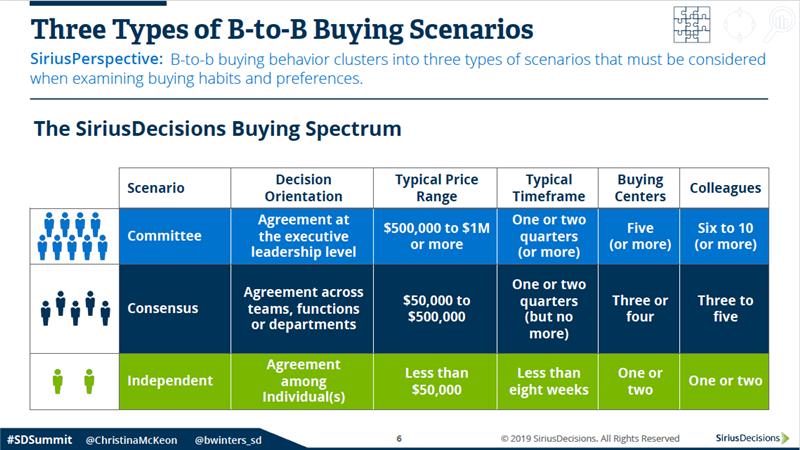
Here’s where it gets interesting. This year, two-thirds (66%) of buying scenarios fell into the consensus or committee scenario, up from 59% just two years ago. To add even more complexity, it takes an average of 17 interactions to complete a purchase with about half being non-human (i.e., digital) and half being human.
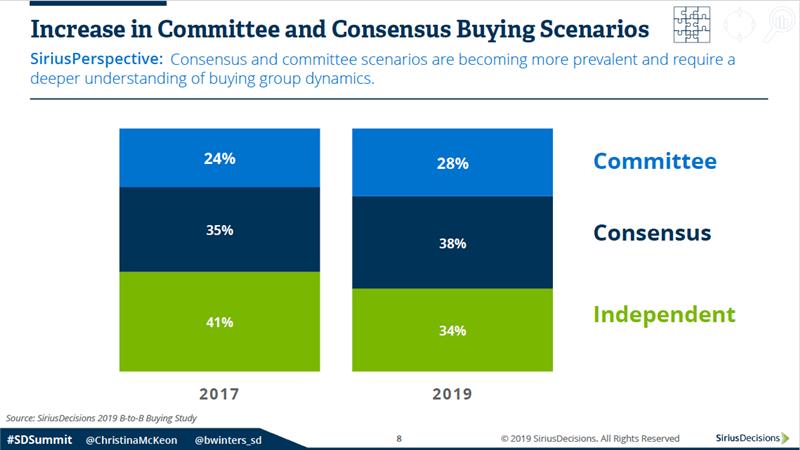
Adapt Your Messaging Strategy
Here at Content4Demand, we follow the SiriusDecisions model for our B2B content marketing. If you do, too, you’re familiar with the Messaging Nautilus™. In their presentation at the Summit, Winters and McKeon focused particularly on Arc 4 and Arc 8 and how they are affected by the new buyer’s journey.
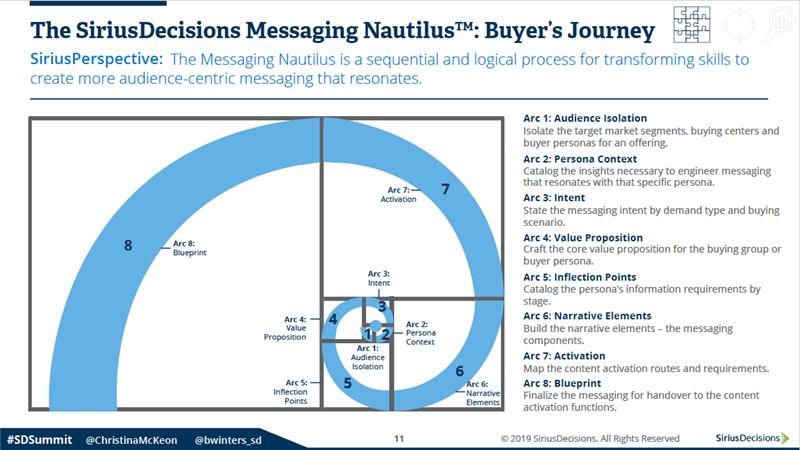
Speak Both to Groups and Individuals
Our presenters emphasized that when you’re targeting a large buying group, you need to develop value propositions that bridge the individual personas. The buying group value proposition must address a need, the “desired outcome for the buying group and the associated value.”
How do you go about doing this? It starts by looking at the organizational, functional and individual needs or each persona in the group. Looking at the example presented by Winters and McKeon, we see that for the CMO, the organizational need revolves around leveraging customer data. At the functional level, it’s about demonstrating marketing’s contribution to revenue. Finally, at the individual level, the CMO wants to be able to influence business strategy more to improve the market position.
Once you identify these persona-level needs for all the personas in the buying group, Winters and McKeon teach that you need to look for common themes. How does your offering address these common needs? What’s the desired outcome? What distinguishes your offering from others’?
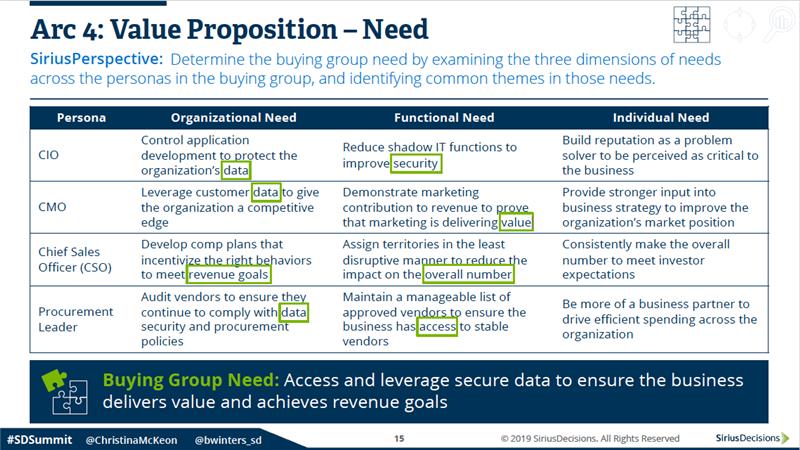
The B2B Blueprint
The good news, as noted by our presenters, is that when you’re developing your messaging “blueprint” for the activation team, you’re pulling from the work you’ve already done in arcs 1 through 4 of the Messaging Nautilus. Winters and McKeon shared a template to create this blueprint for the buying group as a whole in addition to the ones you’ve created for the individual personas.
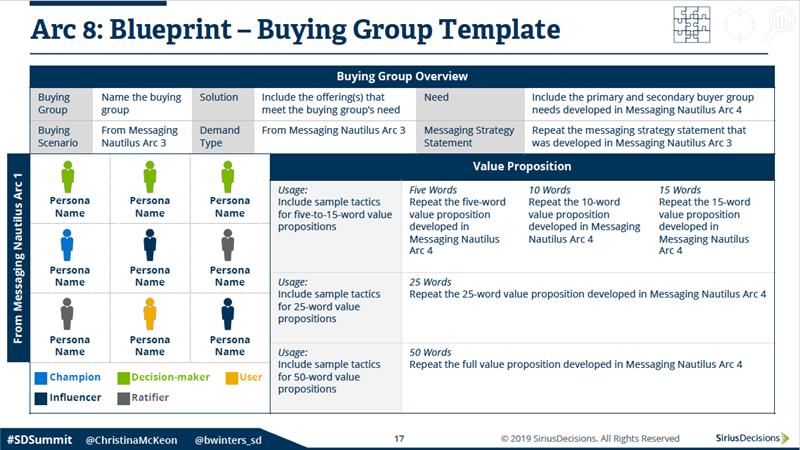
The beauty of the blueprint is that it identifies each member of the buying group and then pulls in the overview information from your previous messaging work, including 5-, 10-, 15-, 25- and 50-word value proposition statements.
Informed Messaging
With way too much information to share in one blog post, I’ll leave you with some additional interesting and valuable insights from the SiriusDecisions research on the buyer’s journey.
- C-suite executives are engaged early in the process, with 100% of CIOs engaged at the selection stage in committee scenarios and 83% as decision makers.
- Ratifiers — procurement, legal, finance — are involved at all three stages of the buyer’s journey in the committee scenario. Their peak involvement is in the solution stage, not the selection stage.
- Ratifiers want analyst reports, case studies and other proofs to make an accurate competitive assessment. Eighty-one percent of purchases stall in the buying process, and the number one reason is competitive assessment. You need to address those needs earlier in the process and turn them into your champions.
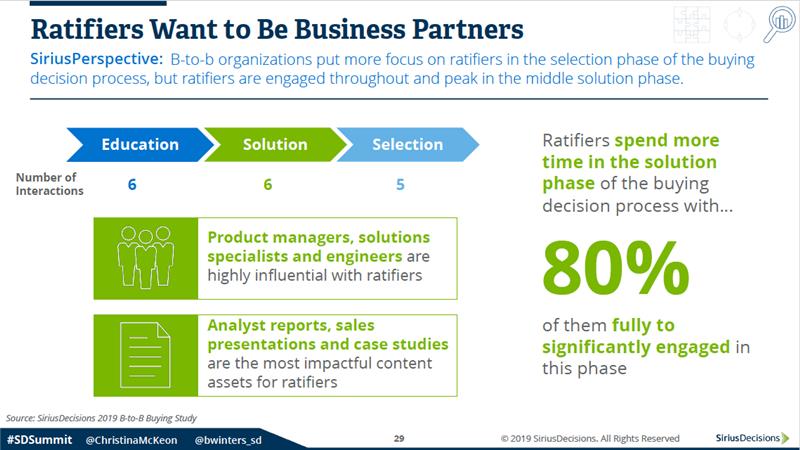
With a little extra effort, you can make sure your messaging truly speaks to the needs of the buying group as well as each person in it. If you need help with messaging development, Content4Demand is here for you. Contact Holly Celeste Fisk at holly@content4demand.com.
To dig deeper into messaging, read Brenda’s recent post “Messaging Maps: Lighting the Way to Buyer-Focused Content.”



